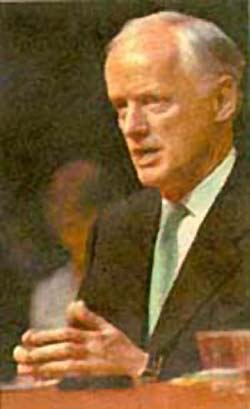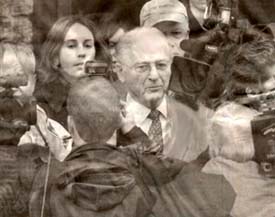 |
NEWS: July 26, 2003
Bird's Eye View of the News
Atila Sinke Guimarães
A MIRAGE THAT DISAPPEARS - Fortunately the mirage of Vatican II as a valid council is disappearing in many Catholic circles. As the winds of reality blow over it, people are realizing its errors and fantasy. I am speaking specifically about the feature article of the recent May issue of The Catholic World Report entitled "The End of Gaudium et Spes," questioning the objectivity and feasibility of this pastoral constitution. The article casts doubt on not only Gaudium et Spes, but also the ensemble of Vatican II. The piece, written by James Hitchcock, a Professor of History at St. Louis University and founder of the Fellowship of Catholic Scholars, is solid, honest, and worthy of being included in the files of any researcher on the topic. I will comment here on just one excerpt.
Hitchcock observes:
"In many ways the promise of the Council has not been fulfilled, as the immediate effect of the Council .... was to plunge the Church into an internal crisis more severe than any other in her History. The crisis was provoked by the fact that, almost immediately at the Council's end, there occurred the worldwide cultural phenomenon now popularly known as "the Sixties," amounting to nothing less than a frontal assault on all forms of authority. The cultural map itself changed rapidly, so that many of the assumptions found in the conciliar decrees were rendered obsolete. The Council fathers apparently had no inkling of that coming crisis; the task of "reading the signs of the times" was apparently far more difficult than was imagined in the euphoric days of the early 1960s."
Even though this conclusion is not an original one1, I praise Hitchcock for his honest portrayal of the reality. The Council did, in fact, initiate the worst ecclesiastical crisis in the History of the Church. It also failed to see the reality of the world that it claimed the Church should adapt to. Hitchcock's sharp irony is worthy of note: the conciliar fathers grandiosely imagined themselves as "prophets" predicting the future, but they were not able to correctly analyze even the present times that were before their very eyes...
Hitchcock made some other interesting points:
- Regarding Vatican II: The optimism of the Council and its omission to identify the evil of the modern world tacitly promoted the coming crisis in the Church;
- Regarding John Paul II: He is not the "reactionary" the media presents; he is not very concerned about the sex-abusers in the clergy; he avoids facing the mass apostasy in the Church; many of his arguments are open to discussion (his denial of capital punishment and the past doctrine of just war, his affirmation that the “root causes†of terrorism are poverty and lack of human rights);
- Regarding socio-political issues: The defeat of Communism was not caused by dialogue with the atheists; the full support that the Vatican gives to the United Nations is incomprehensible since this organization is clearly anti-Catholic, promoting "sexual freedom" and the legalization of abortion as human rights.
Hitchcock goes even further. A little before finishing his article he raises this courageous question: Isn't such optimism heretical since it does not acknowledge the existence of sin?
It is good to know that there is a growing number of concerned Catholics who are no longer being held by the magic spell of Vatican II and are abandoning their blind-obedience to the progressivist religious authority.
MORE THAN 1,000 CASES - The number of sexual abuse victims only in the Boston Archdiocese in the last decades "likely exceeds 1,000" and involves more than 250 clergy and other Church workers.

Keating: The Bishops cover-up follows a mafia style
|
These conclusions are part of the 76-page report based on Church records that Attorney General Tom Reilly released July 23. The report was made based on the data of a 16-month investigation, the more exhaustive work made on the topic to date by any public authority since the clerical abuse scandal began in Boston early last year. Reilly called the number of victims 'staggering' and declared: "This is the greatest tragedy for all children, ever, in this commonwealth in terms of sex-abuse" (Los Angeles Times, July 24, 2003). Prosecutors in New Hampshire and Long Island are making similar efforts to use Church records to document long standing cover-ups of child sexual abuse by priests.
Reilly describes the general episcopal policy adopted as a "massive, inexcusable failure of the leadership in the Archdiocese of Boston." The problem was not only the "deliberate, intentional choices" made to protect the guilty at the expense of innocent children, but also the fact that during the last decades the Church aggressively lobbied against attempts to broaden statutes that would have required self-reporting by clergy (ibid.).
Reading such conclusions and confirmations of the ongoing cover-up by Bishops as well as their refusal to provide information, one remembers the fitting remark made by ex-governor Frank Keating one month ago. He compared the Bishops to La Cosa Nostra, another name for the Mafia (Los Angeles Times, June 15, 2003). Keating's comparison was certainly objective regarding some Californian Bishops. With the release of this Boston report, however, it seems the comparison could be extended to apply to several of their colleagues in the Boston Archdiocese. Would only the Bishops of Massachusetts and California deserve this epithet, or could it include some from other States as well? I leave this question for the reader to answer.
A NETWORK OF HORROR? - This week new and important charges were made against Fr. Paul Shanley. He and Fr. John Geoghan can be considered the two main 'stars' that gave origin to the pedophile scandal still shaking the Catholic Church in the U.S. According to documents filed in Boston on July 21, Fr. Shanley would have procured underage sex partners for other men in exchange for money. He also would have paid for sex with teenagers.

Fr. Paul Shanley was released in December on $300,000 cash bail.Los Angeles Times, December 12, 2002
|
The accusations were included in more than 300 pages of motions filed by attorneys representing Gregory Ford, 23, and his parents in a civil suit against Cardinal Law and the Boston Archdiocese. The Fords contend Church officials failed to stop Shanley from abusing children. The documents, laying out dozens of examples of alleged wrongdoing by Shanley and his superiors, were filed hours after the State Attorney General confirmed that no criminal charges would be brought against Law (Los Angeles Times, July 21, 2003).
If these charges are objective, they would add graver aspects to the scandal. There would be a much more serious crime than the so-called personal 'weakness' of the priests, as their superiors have benevolently viewed these abuses against children. Shanley, and perhaps other priests, would have set up a kind of business exploiting homosexual prostitution with children. In fact, to pay for sex with children can only be called what it is, child prostitution, and someone who makes money for offering children for the sexual pleasure of other men does nothing other than to serve as a pimp. That is to say, a network of horror exploiting child prostitution would have been established under the sightless eyes of the ecclesiastical authorities.
If prudence advises caution in launching this accusation, vigilance obliges us to raise the suspicion. Let us wait and see if other data will show up to confirm or deny it.
1. Please check in Animus Delendi II a quote by Prof. Plinio Correa de Oliveira on p. 5; my comments on pp. 20-1, and a quote by Fr. Edward Schillebeeckx in note 8a (ibid.), which assert precisely the same thing.

|
News | Home | Books | CDs | Search | Contact Us | Donate

©2002- Tradition in Action, Inc. All Rights Reserved
|
 |
|